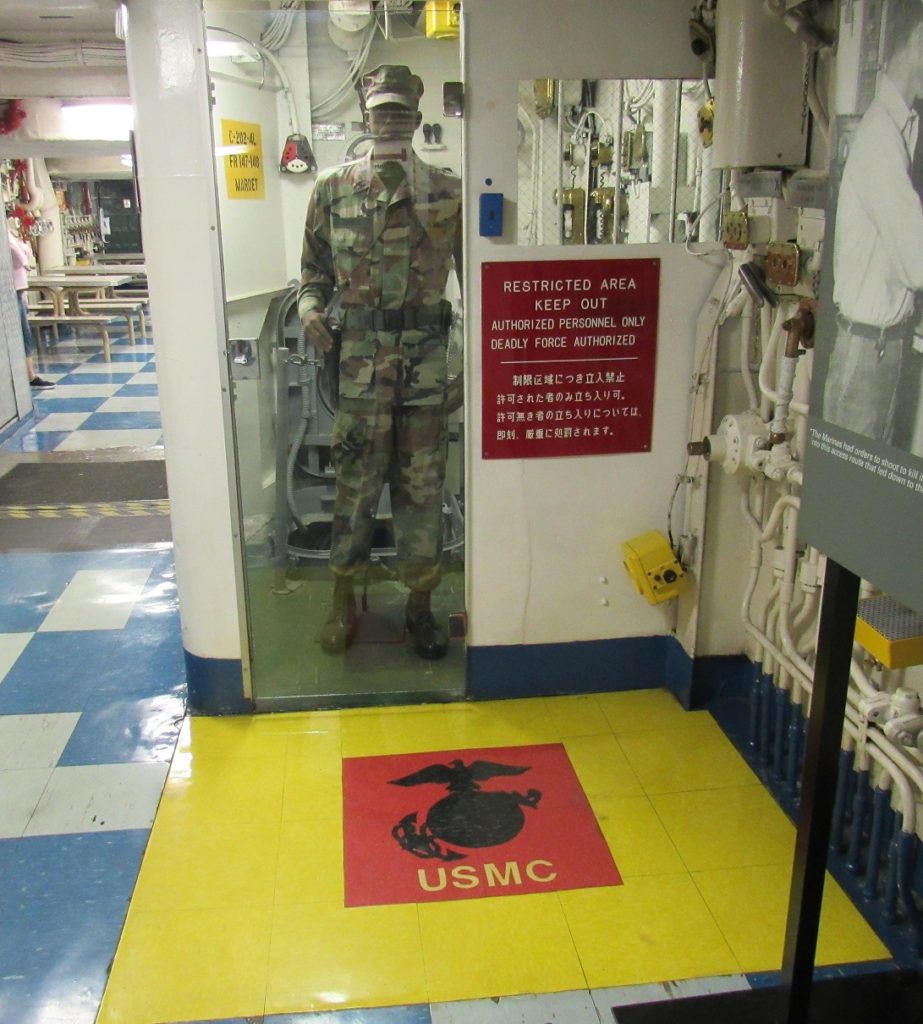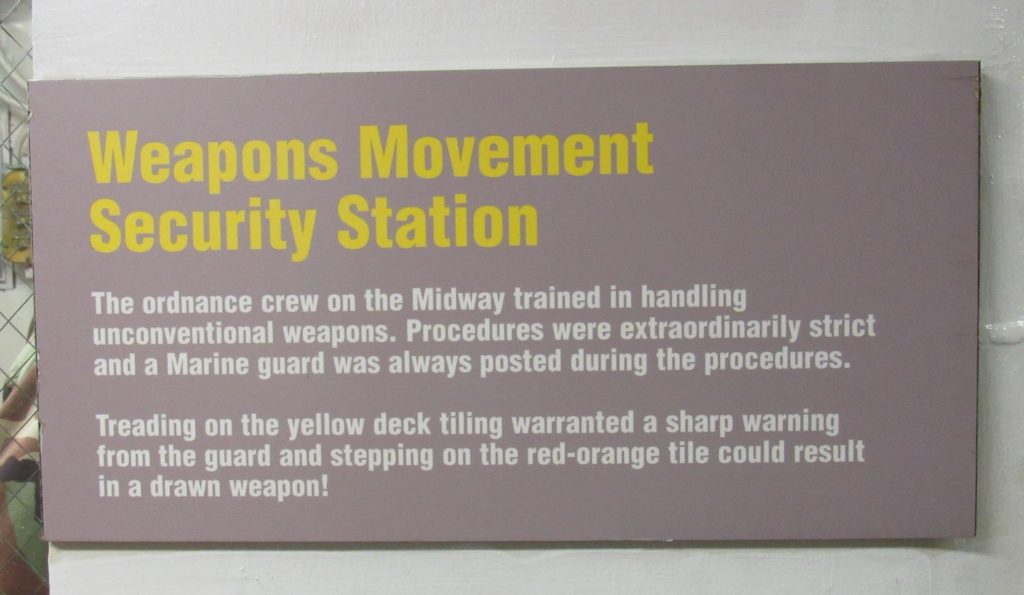
On a recent tour of the Midway Museum in San Diego I walked past the door to the “special weapons” area. The “special” means nuclear.
I’ve noticed that area on previous times aboard the U.S.S. Midway, but paused to ponder this visit.
This time I wondered:
- How many nukes did a US carrier have on board?
- What types?
- What airplanes were equipped to carry nukes?
As an amusing coincidence, I asked one of the docents if he is aware of open source documents which describe the nuclear loads on carriers. He did not know, but we had a delightful conversation.
Turns out this docent had a parallel job to what I did when I was in the U.S. Air Force. He was based on SSBN submarines while he was in the Navy, having keys to launch the Polaris SLBM. Like I said, what a fun coincidence.
Well, that triggered my curiosity, got me doing a little research, and I found some good materials for starters.
One specific tidbit in the second article link below is directly responsive to my curiosity – the article asserts U.S. aircraft carriers typically carried 100 nuclear weapons on board during the Cold War.
Update: Just so you know, every word I say in my discussions of nuclear weapons is based on what I have read in a public, open-source document. I don’t know anything else at all about nukes.

Two articles got me started:
- 2/3/16 – Federation of American Scientists – Declassified: US Nuclear Weapons At Sea
- 1/8/16 – Robert S. Norris & Hans M. Kristensen (2016) Declassified: US nuclear weapons at sea during the Cold War, Bulletin of the Atomic Scientists, 72:1, 58-61, DOI: 10.1080/00963402.2016.1124664 – alternate link here.
Both articles point toward documents declassified by the United States quantifying the number of nuclear weapons deployed at sea as of September 30 from 1953 through 1991. Declassification was in February 2015, meaning the most recent data was approximately 25 years old. That makes sense – anything more recent could give away clues regarding current strategy and deployment.
Data released does not give types of weapons and has no more detail than three broad categories: weapons in the Pacific, Atlantic, and Mediterranean.
A few preliminary comments in the first article above, from the Federation of American Scientists:
Everyone knows that strategic missiles carrying strategic nuclear weapons are on SSBNs. It is also generally known that during the Cold War nukes were carried on aircraft carriers, battleships, attack submarines, cruisers, destroyers, frigates, and even supply ships.
I did not know that frigates and destroyers carried them. If I had thought further, I would have realized those ships were so armed and also that a lot of supply ships would have have them on board for transport.
Article points out what everyone who has spent any time thinking about nukes is fully aware. Specifically the concentration of weapons in the Atlantic and Mediterranean shows the focus of nuclear strategy during the Cold War was deterring the Soviet Union, the good ol’ Evil Empire.
Another reason for the 1991 cut off in data is because that’s when the Soviet Union collapsed and then President Bush ordered all non-strategic weapons start being offloaded from U.S. Navy ships. Article says that took a couple years, as revealed by the published photo from the aircraft carrier U.S.S. Kennedy showing the “Last W-Division” on 2/17/93. That means it was last nuclear weapons handling crew on the Kennedy.
In 1993 President Clinton announced the last of the nukes would be removed.
After that drawdown the only nukes in the Navy were strategic weapons on top of SLBMs carried on ‘boomers.’
Since Federation of American Scientists is an anti-nuclear partisan, most of the article focuses on accidents at sea which involved a ship carrying nukes.
Also described are incidents in which a weapon was lost, such as when an A-4 Skyhawk loaded with a B43 rolled over board on 12/5/65. The aircraft, bomb, and pilot sank 2700 fathoms (4900 meters / 16,200 feet) to the bottom of the ocean. Obviously at that depth, neither pilot, aircraft, nor aircraft have been recovered.
Why an A-4 was going to take a flight loaded with a live nuke is not immediately apparent to me. My only guess is that to maintain proficiency the W Division, aircraft crews, and flight deck personnel had to train with live weapons.
Article in the Bulletin of the Atomic Scientists cited above has a number of interesting comments worth mentioning.
Article asserts the offloading of non-strategic nukes was completed during the summer of 1992.
Ballistic missile subs (‘boomers’) were all stationed in the Atlantic until the early ‘80s. The number of warheads increased in the early ‘70s with deployment of MIRVed warheads (Multiple Independently-targeted Reentry Vehicles), meaning each missile could carry multiple warheads.
Starting in about 1982 increasing number of Ohio class subs with Trident missiles allow deployment of boomers into the Pacific and also increased the number of warheads onboard.
Article explores reasons that the released information shows zero weapons in the Mediterranean after 1986. It is known that nuclear armed aircraft carriers and nuclear armed SSBNs patrolled in the Mediterranean, so there obviously were U.S. nukes in the Med sometimes.
Speculation in the article points to the the official count is made as of September 30 of each year, so ships cruising in the Med during the year would not count.
Another speculation is the categories of Atlantic, Pacific, and Mediterranean are based on weapons assigned to fleets in those areas. Thus, the tally in the Mediterranean would include weapons assigned to the Sixth Fleet, which does not have any SSBNs. So when the nukes were offloaded from attack subs and surface ships in Sixth Fleet, there were zero weapons assigned to the Mediterranean.
Article says twice that aircraft carriers were loaded with about 100 nuclear bombs when deployed. Over time there were 12 nuclear-capable aircraft able to carry nukes.
Types of non-strategic weapons included bombs deliverable from fighters, nuclear depth charges, surface-to-air missiles, land-attack cruise missiles, anti-submarine rockets, and nuclear torpedoes.